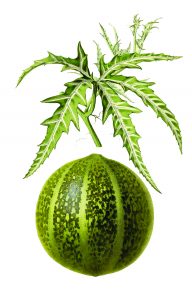When my now 27-year-old daughter, Alisa, was growing up at Green Gulch Farm Zen Center, she regularly prowled the fields with a roving posse of renegade Zen kids. These young ruffians disappeared all day long into dense blackberry thickets, to emerge at dusk with rough wooden machetes fashioned to slash down 9-foot-tall poison hemlock plants menacing the neat lettuce rows at the edge of the farm.
Chagrined by their feral behavior, a few Zen parents organized family practice days, taking turns to offer simple interactive programs for our children, grounded in the original teachings of the Buddha. I planned a summer session on the noble eightfold path with Reverend Heng Sure, the director of the Berkeley Buddhist Monastery, who came to the family program strumming his guitar and belting out this sassy rendition of the noble truths:
“Ouch,” says Suffering,
“Mooooore,” says Craving,
“Stop!” says Cessation,
“Walk the noble eightfold path.”
 Our Zen kids loved both this catchy mantra and imitating Reverend Heng Sure. With their interest piqued, they decided to plant a noble eightfold path garden in the shape of an eight-spoke wheel. It became my summer work to help realize this garden.
Our Zen kids loved both this catchy mantra and imitating Reverend Heng Sure. With their interest piqued, they decided to plant a noble eightfold path garden in the shape of an eight-spoke wheel. It became my summer work to help realize this garden.
As sons and daughters of practicing Buddhists, our children understood that the teachings of the eightfold path are divided into three categories—wisdom, morality, and concentration. To make these categories clear in their garden design, they chose signage marked with three primary colors: blue for clear-eyed wisdom, yellow for warm-hearted morality, and red for fiery concentration.
I was surprised to see how avid the children were in creating their garden. They loved selecting the best plants for their design. For right view, in the wisdom section, they chose eyebright, a medicinal herb that fosters clear vision, and for wisdom’s matching virtue, right intention, they planted a rich mix of cover crop seed to feed the garden ground.
In the threefold category of ethical morality, the young Zen gardeners chose the revered Three Sisters plant trio of Native American antiquity and traditional ecological knowledge: corn, beans, and squash. In this category they selected Dragon Tongue beans for right speech, open pollinated Golden Bantam sweet corn for right action, and sugar pumpkins for right livelihood, with the secret entrepreneurial intention to sell this crop back to the sangha at Halloween.
In the last category,that of deep concentration, the kids planted indigo-seeded sunflowers for right effort, rosemary and lavender for right mindfulness, and stinging nettles for right concentration (since just a tiny, concentrated sting of the nettle goes a long way).
It has been almost 15 years since this noble eightfold garden was planted in the area we now nostalgically call the Children’s Garden. A few months ago I walked the remnants of this plot and noticed that eight clear organic gardening principles rose up for me out of the folds of the ground:

RIGHT VIEW is to have no fixed view of what a garden is and to allow the voice of the uncultivated watershed to guide the design.
This insight came from noticing that the original eyebright plants of the first garden bed had long ago yielded to a wild jumble of California native plants indicating original fertility far beyond the cultivated imagination.
RIGHT INTENTION is to keep your garden beds covered with a mixed mantle of diverse plants in order to protect and build soil health.
Here on the original site of the Children’s Garden, cover crop plants have continued to thrive and grow, creating one of the most fertile pieces of paradise in the garden, a little slice of Eden, humming with life.
RIGHT SPEECH is to proclaim the importance of protecting and saving seed as the source of life and the embodiment of biocultural diversity in every garden.
In this section of the eightfold garden, Dragon Tongue beans covered the ground with their brightly patterned seed for many seasons. We continue to collect, share, and sow this heirloom seed today.
RIGHT ACTION is to garden organically without the intervention of chemical fertilizers, pesticides, or herbicides, and to plant seeds free from genetic modification.
This section of the garden reminded me that corn is one of the most genetically engineered plants in the modern marketplace, a practice not sanctioned by organic agriculture. In the 15 years since establishing the Children’s Garden, we have been committed to planting only open-pollinated varieties of corn. This season a prolific stand of Oaxacan Green Dent corn graces the Zen fields.
 RIGHT LIVELIHOOD is to focus on growing plants in interactive poly-cultural guilds and to celebrate each diverse harvest with your community.
RIGHT LIVELIHOOD is to focus on growing plants in interactive poly-cultural guilds and to celebrate each diverse harvest with your community.
Although the first sugar pumpkins of this bed were harvested long ago, I still remember how voluptuous that initial harvest was and how excited our kids were to celebrate within the “lively hood” of their Zen sangha.
RIGHT EFFORT is to grow plants that will nourish the web of life and provide integrated pest management in the garden.
The original Hopi Black Dye sunflowers sown in the Children’s Garden continue to offer a thriving source of pollen and nectar for the farm and garden, reminding us to always plant for the pollinators and to share the wealth of every harvest with the more-than-human world.
RIGHT MINDFULNESS is to invite the unknown into the garden by bringing heart and mind together in the present moment.
When we first planted the Children’s Garden, I mentioned our first garden teacher, Alan Chadwick, who always planted rosemary for remembrance and lavender for comfort in every garden he grew. Accordingly, our kids selected these two plants as primary guides for mindfulness in their eightfold garden.
RIGHT CONCENTRATION is to welcome dangerous and powerful plants into the garden and be nourished by the concentrated strength of these guardian plants.
I was most surprised by the children’s selection of nettles for their garden. Since it is difficult for nettles to grow in cultivated gardens, our kids took to harvesting them from the wild and bringing these undomesticated plants into the kitchen to be made into nettle broth, which still serves as the base for our most nutritious and flavorful soups.
The Buddha began and ended his long teaching life by walking the noble eightfold path of wisdom, morality, and concentration, and applying his timeless teachings to every aspect of practice. His commitment encourages a fresh adaptation of these original teachings today for children, organic gardeners, and seasoned practitioners alike. May all beings in the ten directions follow this ageless path.